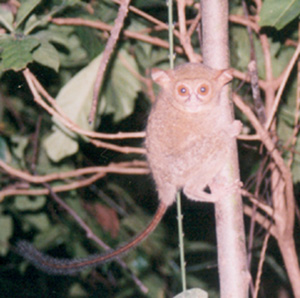|
| 질의: Mammal | 결과: 1617번째/3457 | |
Spectral Tarsier (Tarsius tarsier) - Wiki
| 제목: | Spectral Tarsier (Tarsius tarsier) - Wiki
| |

| 해상도: 300x298
파일크기: 41725 Bytes
등록시간: 2007:10:08 15:03:46
|
Spectral Tarsier
From Wikipedia, the free encyclopedia
[Photo] Spectral Tarsier (Tarsius tarsier). Spectral Tarsier {Tarsius spectrum) Tangkoko National park, Sulawesi, Indonesia Photographer: http://en.wikipedia.org/wiki/User:Bwmodular | Permission is granted to copy, distribute and/or modify this document under the terms of the GNU Free Documentation License, Version 1.2 or any later version published by the Free Software Foundation; with no Invariant Sections, no Front-Cover Texts, and no Back-Cover Texts. A copy of the license is included in the section entitled "GNU Free Documentation License". |
The Spectral Tarsier (Tarsius tarsier) is less adapted than the Philippine Tarsier or Horsfield's Tarsier; for example, it lacks adhesive toes. It is the type species for the Tarsius genus. It is found in Indonesia, primarily in the lowlands of Sulawesi and on Selayar Island.
The Spectral Tarsier has the largest eye to body size ratio of all of the mammals.
http://en.wikipedia.org/wiki/Spectral_Tarsier
| The text in this page is based on the copyrighted Wikipedia article shown in above URL. It is used under the GNU Free Documentation License. You may redistribute it, verbatim or modified, providing that you comply with the terms of the GFDL. |
|
댓글 |
|---|
| | 손님 |
|
Scientific Name: Tarsius tarsier (Erxleben, 1777)
Common Names:
English – Spectral Tarsier, Sulawesi Tarsier, Eastern Tarsier, Selayar Tarsier
French – Tarsier Des Célèbes
Synonyms:
Tarsius buffonii Link, 1795
Tarsius daubentonii Fischer, 1804
Tarsius fuscomanus Fischer, 1804
Tarsius fuscus ischer, 1804
Tarsius macrotarsos Schreber, 1778
Tarsius pallassii É. Geoffroy Saint-.Hilaire, 1796
Tarsius podje Kerr, 1792
Tarsius spectrum Pallas, 1778
Tarsius spectrum (Pallas, 1779) |
^o^
동물그림창고 똑똑전화 누리집
^o^
|
|
|